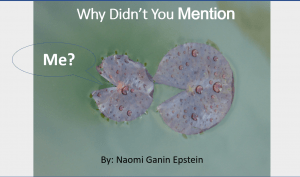
In theory, visualising a difficult concept is supposed to make it easier for the students to grasp it.
Naturally, achieving the desired outcome depends on visualising the material in a manner the students can relate to.
Many of my Deaf and hard of hearing students adolescent students have a lot of trouble answering questions constructed as “What is _______ an example of?” / “Why is __________ mentioned in the text?”
As in the following example:
Yossi got many gifts for his birthday. He got some books, three shirts and a helmet for his motorcycle.
What is a helmet an example of?
Some of my students would think the correct answer was:
“A helmet is an example of something you put on your head” or ” “…something you use for your motorcycle”
Yet the correct answer is:
“A helmet is an example of a gift Yossi got for his birthday”.
The students need to answer such questions on their final exams.
Sigh…

Naomi’s Photos
Till now I began by practicing such question types with the students in their mother tongue first, since understanding the question format itself and the thinking process required, is crucial.
Then we practiced answering sample questions in English. Here’s a downloadable worksheet I use.
All of this helped, it really did.
But not enough.
Some students still have difficulties in answering such questions correctly.
I wondered if visualising the issue in the context of a simple story would help the students, in addition to what we are already doing.
And so, the story of D.G., an angry 10 sided dice who doesn’t want to be called by his full name (Decagon), was born. When D.G. introduces us to his family, he presents us with many examples of such structures in context. He feels forgotten since no one seems to mention him…
Since a tale about a family of dice is so completely unconnected to a specific culture or age group, I believe the characters could be easily used with a wide variety of students.
Only time will tell whether the presentation will have the desired impact.
But in any case, brilliantly colored multi-sided dice are pretty cool, don’t you think?
You can download the presentation by clicking here:
Why didn’t you mention me
Note: This slideshow contains animated effects. My attempts at having the slideshow embedded in the blog while presenting all elements were, sadly, unsuccesful.
I don’t teach deaf students, but I wonder if this specific kind of question/ difficulty has anything to do with them having a hearing disability.
I see it more as a syntactical skill that is missing, and I am not sure that “regular” people (people without hearing problems, could handle this one well, due to the reversed sentence structure. Since hearing and speaking are mirrored skills, I guess that not “speaking” the structure (verbally, or using sign language), makes it harder to “hearing” it (as in grasping it, visualizing it, conceptualizing it).
Maybe an accommodation is needed here, or sort of mediation that would make the question more conceivable. I think that rephrasing this question to: ” The color red is an example of …….
(No question mark, not an interrogative structure, but a simple positive sentence structure). The instruction would then be: “Complete the sentence”.
To sum up, in my opinion that kind of question goes to struggling students in general, not related to having a hearing disability.
Changing these questions (that are very common in the Bagrut exams) would make the answer more accessible/ retrievable, due to a simplified sentence structure.
Again, since I don’t work with hearing disabled, I may be missing something as for how syntax is formed in sign language and so is grasped as a visualized concept. But to ,y best knowledge, research has shown that deaf people convert signs to sounds even though it seems contradictory to them being unable to hear. It’s an intriguing issue indeed!
Hagit!
Thank you so much for taking the time for such a thought-provoking comment!
I’m going to try your suggestion for rephrasing the question as a stepping stone to dealing with the exam format of the question.
It is interesting to note that the students who have more serious problems dealing with these questions are not the ones who are native sign language speakers, but rather the ones who grew up in hearing families. The time lost until they were identified as having a significant hearing loss, got a cochlear implant or hearing aids is precious language development time that was lost to them.
Yours,
Naomi
Hi Naomi,
Thanks for sharing this. I read the question and had no idea what kind of answer it was looking for. It wasn’t transparent to me at all – I would also have gone for the definitions that your students went for. That seems like a very odd choice of question! I’m assuming it’s a national-level thing though that you can’t do anything about?
The story sounds like an interesting approach – good luck!
Sandy
Sandy,
Your comment is very interesting – you mean you haven’t encountered such questions on exams you prepare for? Interesting!
If not, could the story be of any use to you at all?
Thanks!
Naomi